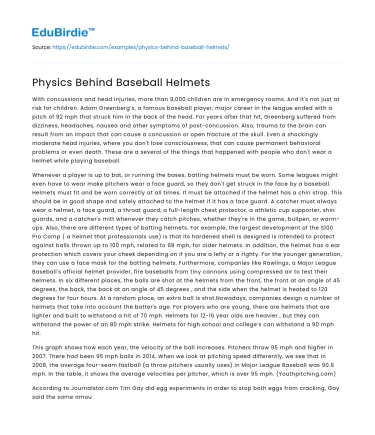With concussions and head injuries, more than 9,000 children are in emergency rooms. And it's not just at risk for children. Adam Greenberg’s, a famous baseball player, major career in the league ended with a pitch of 92 mph that struck him in the back of the head. For years after that hit, Greenberg suffered from dizziness, headaches, nausea and other symptoms of post-concussion. Also, trauma to the brain can result from an impact that can cause a concussion or open fracture of the skull. Even a shockingly moderate head injuries, where you don't lose consciousness, that can cause permanent behavioral problems or even death. These are a several of the things that happened with people who don't wear a helmet while playing baseball.
Whenever a player is up to bat, or running the bases, batting helmets must be worn. Some leagues might even have to wear make pitchers wear a face guard, so they don't get struck in the face by a baseball. Helmets must fit and be worn correctly at all times. It must be attached if the helmet has a chin strap. This should be in good shape and safely attached to the helmet if it has a face guard. A catcher must always wear a helmet, a face guard, a throat guard, a full-length chest protector, a athletic cup supporter, shin guards, and a catcher's mitt whenever they catch pitches, whether they're in the game, bullpen, or warm-ups. Also, there are different types of batting helmets. For example, the largest development of the S100 Pro Comp ( a helmet that professionals use) is that its hardened shell is designed is intended to protect against balls thrown up to 100 mph, related to 68 mph, for older helmets. In addition, the helmet has a ear protection which covers your cheek depending on if you are a lefty or a righty. For the younger generation, they can use a face mask for the batting helmets. Furthermore, companies like Rawlings, a Major League Baseball's official helmet provider, fire baseballs from tiny cannons using compressed air to test their helmets. In six different places, the balls are shot at the helmets from the front, the front at an angle of 45 degrees, the back, the back at an angle of 45 degrees , and the side when the helmet is heated to 120 degrees for four hours. At a random place, an extra ball is shot.Nowadays, companies design a number of helmets that take into account the batter's age. For players who are young, there are helmets that are lighter and built to withstand a hit of 70 mph. Helmets for 12-16 year olds are heavier , but they can withstand the power of an 80 mph strike. Helmets for high school and college’s can withstand a 90 mph hit.
Save your time!
We can take care of your essay
- Proper editing and formatting
- Free revision, title page, and bibliography
- Flexible prices and money-back guarantee
This graph shows how each year, the velocity of the ball increases. Pitchers throw 95 mph and higher in 2007. There had been 95 mph balls in 2014. When we look at pitching speed differently, we see that in 2008, the average four-seam fastball (a throw pitchers usually uses) in Major League Baseball was 90.9 mph. In the table, it shows the average velocities per pitcher, which is over 95 mph. (Youthpitching.com)
According to Journalstar.com Tim Gay did egg experiments in order to stop both eggs from cracking, Gay said the same amount of force was required. The impact period was increased by a matter of milliseconds for the egg that hit foam, reducing the outcome of that impact. First, their tough shells distribute force over a larger area, decreasing any spot of force. Second, the cushioning from inside the helmet extends the impact length of time, reducing the maximum momentum. In addition, without a helmet, he said, an area of the skull receiving a hit that will cause a lot of damage may be close to 4 or 5 square inches. He said with a helmet that the same force is spread over an area around one-sixth of the helmet's surface area, or about 50 square inches. So the helmet decreases the force on any part of the skull. If the force was 10 pounds per square inch on just a skull, it is about 1 pound per square inch with the helmet. Drop a 2 pound weight from a height of five yards on a person's head, he said, and it is likely to kill them. The weight will hit their head at a speed of 10 meters per second and will impact an area of about 4 square inches because the skull is curved. The hard shell reduces the force on any spot to about 0.5 pounds per square inch by spreading the blow over a larger area. (Journalstar.com)






 Stuck on your essay?
Stuck on your essay?

